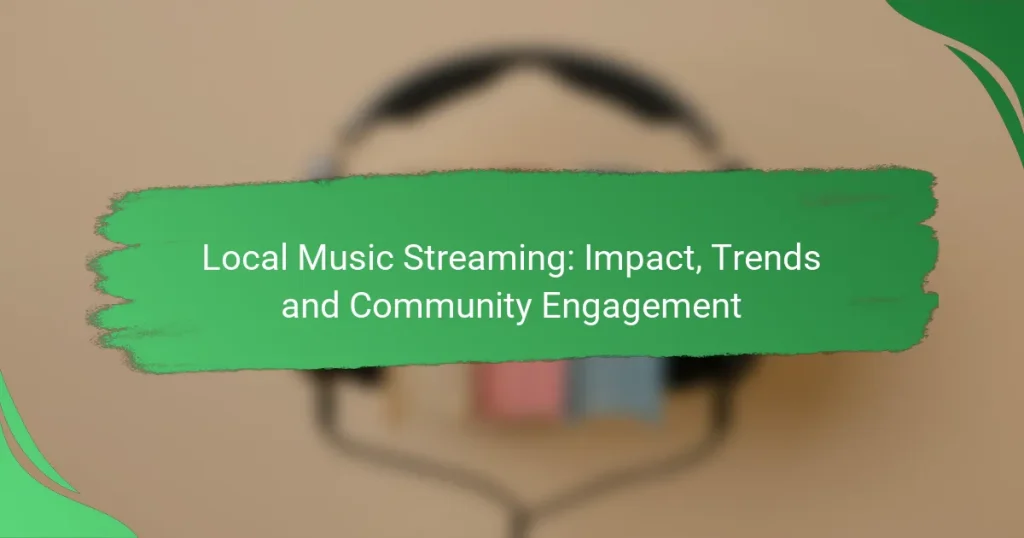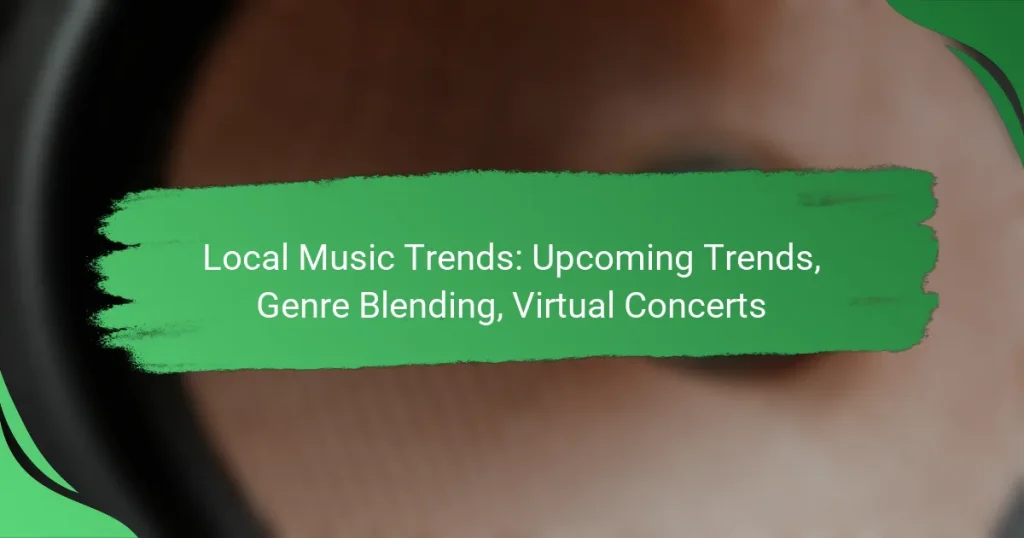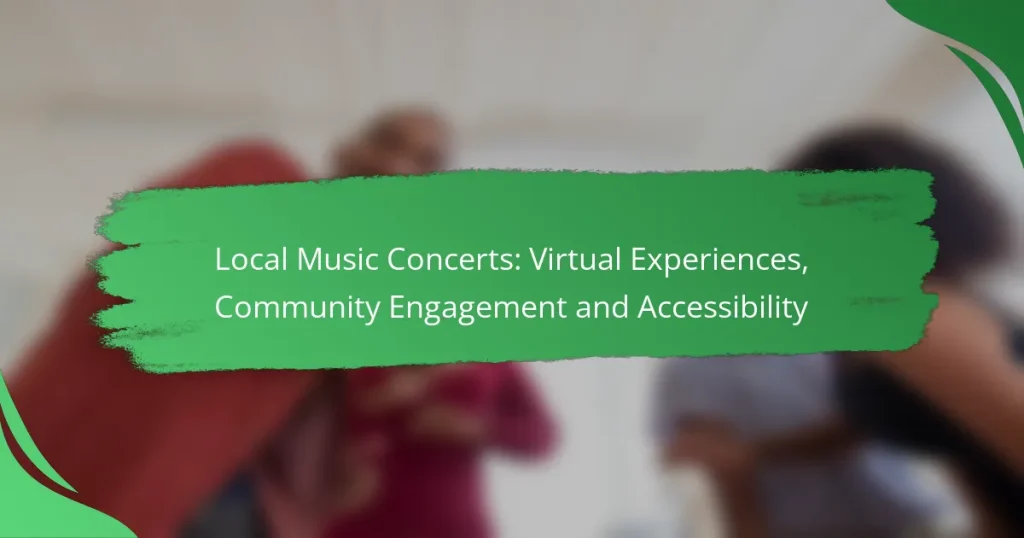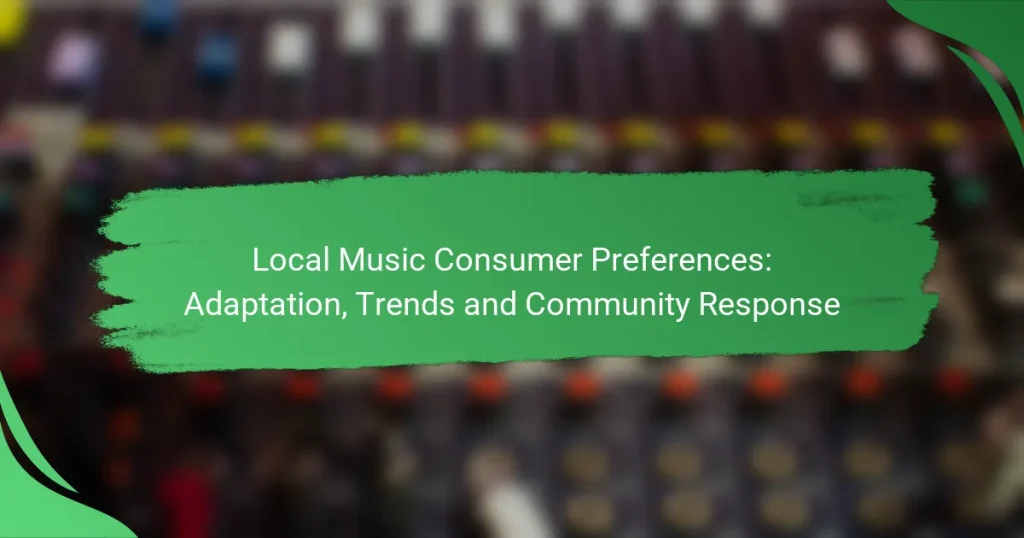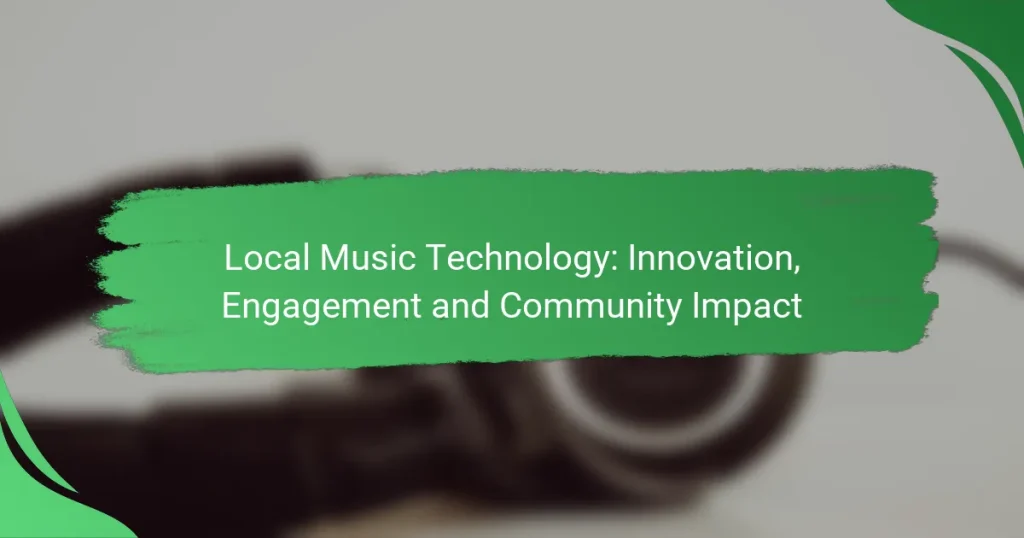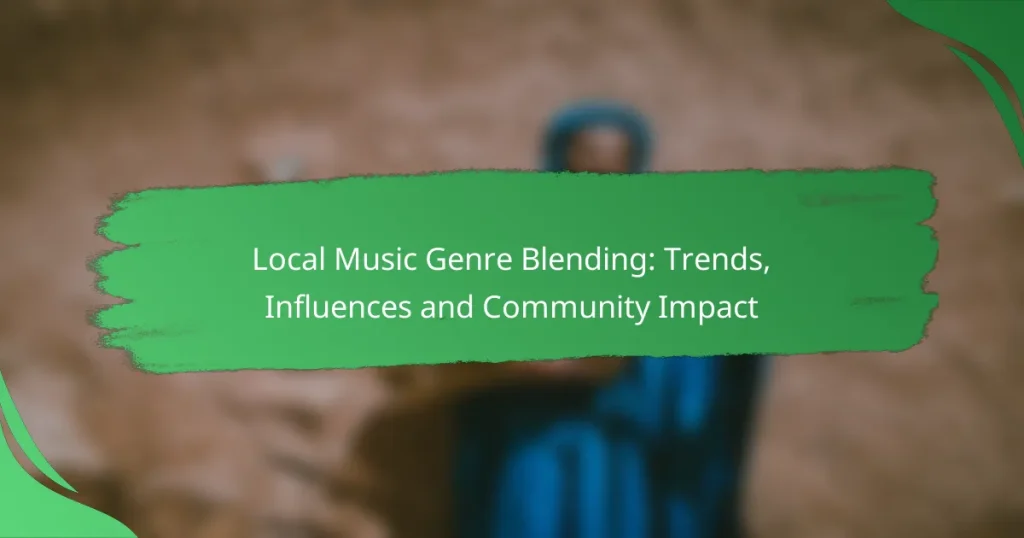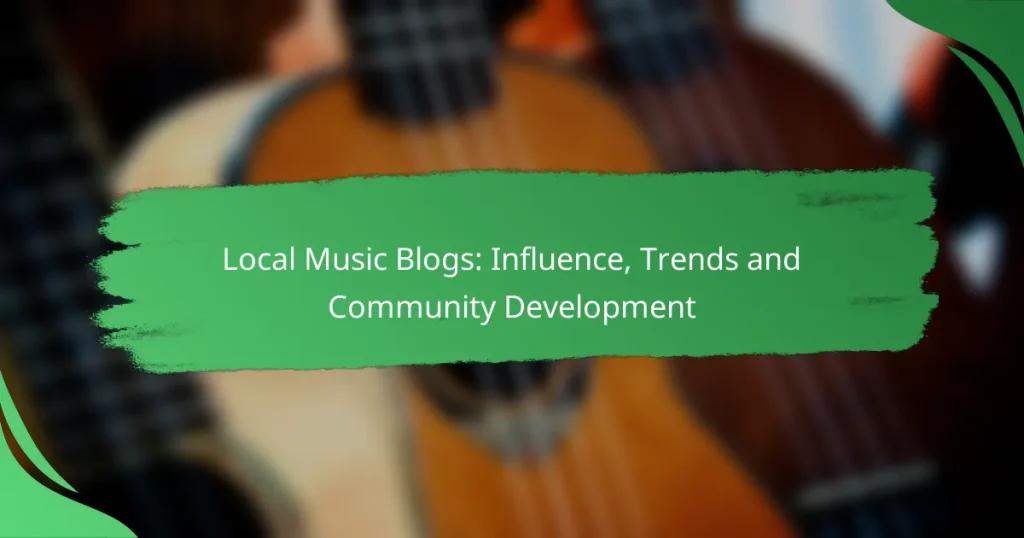The local music scene is undergoing transformative changes, driven by the emergence of independent artists and the increasing reliance on social media for promotion. As virtual concerts gain popularity, venues are adapting their strategies to remain relevant, focusing on safety and technology to engage diverse audiences. Additionally, music festivals play a crucial role in this ecosystem, offering artists a platform to connect with fans and stimulate local economies.
Local Music Trends: Upcoming Trends, Genre Blending, Virtual Concerts
Local Music Concerts: Virtual Experiences, Community Engagement and Accessibility
Local Music Consumer Preferences: Adaptation, Trends and Community Response
Local Music Technology: Innovation, Engagement and Community Impact
Local Music Genre Blending: Trends, Influences and Community Impact
Local Music Blogs: Influence, Trends and Community Development
What are the current trends in the local music scene?
The local music scene is currently experiencing significant shifts, particularly with the rise of independent artists, increased use of social media for promotion, and the growth of virtual concerts. These trends reflect a move towards greater accessibility and engagement for both artists and audiences.
Rise of independent artists
Independent artists are gaining prominence as more musicians choose to self-produce and distribute their music. This shift is largely driven by the availability of affordable recording technology and platforms that allow artists to reach audiences directly, bypassing traditional record labels.
Many local artists are successfully building their brands through grassroots efforts, often relying on community support and local venues. This trend not only fosters creativity but also encourages diversity in music styles and genres, enriching the local scene.
Increased use of social media for promotion
Social media has become a vital tool for promoting music and connecting with fans. Platforms like Instagram, TikTok, and Facebook allow artists to share their work, engage with followers, and create viral marketing campaigns without significant financial investment.
Artists are leveraging these platforms to showcase live performances, behind-the-scenes content, and personal stories, which helps build a loyal fanbase. Engaging content can lead to increased visibility and opportunities for collaboration within the local music community.
Growth of virtual concerts
The rise of virtual concerts has transformed how audiences experience live music. Artists are hosting online performances that can reach a global audience, often using platforms like YouTube, Twitch, or dedicated concert streaming services.
While virtual concerts provide convenience and accessibility, they also present challenges, such as monetization and audience engagement. Artists are exploring various ticketing models, including pay-per-view and donation-based systems, to sustain their efforts in this evolving landscape.
How are local venues adapting to music trends?
Local venues are evolving by implementing new strategies to stay relevant in the changing music landscape. These adaptations focus on enhancing safety, embracing technology, and optimizing space usage to attract diverse audiences.
Implementing safety protocols
To ensure the safety of patrons, many venues are adopting rigorous health protocols. This includes regular sanitization, contactless entry systems, and capacity limits to promote social distancing. Venues may also require proof of vaccination or negative test results, aligning with local health regulations.
Clear communication about safety measures is crucial. Venues should prominently display their protocols on websites and at entrances to reassure attendees and encourage compliance.
Offering hybrid event formats
Hybrid events, which combine in-person and virtual experiences, are becoming increasingly popular. This format allows venues to reach a wider audience by streaming performances online while hosting a limited number of attendees on-site. It caters to those who prefer to enjoy live music from home or are unable to attend due to health concerns.
When planning hybrid events, venues should invest in quality audio-visual equipment and reliable streaming platforms. Offering ticket options for both in-person and virtual attendance can maximize revenue and engagement.
Enhancing outdoor spaces
Many venues are transforming outdoor areas to host events, capitalizing on the growing preference for open-air experiences. This can involve creating temporary stages in parks or utilizing rooftops and patios for performances. Outdoor settings not only provide a safer environment but also enhance the overall concert experience.
When enhancing outdoor spaces, consider factors such as weather conditions, sound quality, and seating arrangements. Providing amenities like food trucks or pop-up bars can further attract attendees and create a vibrant atmosphere.
What role do music festivals play in the local scene?
Music festivals are vital to the local music scene as they provide a platform for artists to showcase their work, attract audiences, and stimulate economic activity. These events foster connections among musicians, fans, and local businesses, creating a vibrant cultural atmosphere.
Showcasing emerging talent
Music festivals serve as a launchpad for emerging artists, allowing them to perform in front of larger audiences and gain exposure. Many festivals curate lineups that feature local and up-and-coming musicians, giving them a chance to shine alongside more established acts.
For instance, festivals often include stages dedicated to local talent, which can lead to opportunities such as record deals, collaborations, and increased social media following. This exposure can significantly impact an artist’s career trajectory.
Boosting local economy
Music festivals contribute to the local economy by attracting visitors who spend money on accommodations, food, and merchandise. This influx of tourists can lead to increased revenue for local businesses, including hotels, restaurants, and shops.
Moreover, festivals often create temporary jobs in event management, security, and hospitality, further enhancing economic benefits. Communities may see a boost in sales during festival weekends, sometimes reaching tens of thousands of dollars in additional revenue.
Creating community engagement
Music festivals foster community engagement by bringing people together to celebrate local culture and music. They often include activities that encourage participation, such as workshops, art installations, and interactive performances.
These events can strengthen community bonds and promote local pride, as residents come together to support their artists and businesses. Festivals may also partner with local organizations, enhancing their impact through outreach and collaboration.
How can artists leverage local trends for success?
Artists can leverage local trends by aligning their music and marketing strategies with the preferences and cultural nuances of their community. This approach not only enhances visibility but also fosters deeper connections with local audiences.
Utilizing local collaborations
Collaborating with other local artists can amplify reach and create unique musical experiences. By partnering with musicians, producers, or even visual artists from the same area, artists can tap into each other’s fan bases and share resources.
Consider hosting joint performances or recording sessions that highlight the local culture. This not only enriches the music but also strengthens community ties, making the collaboration more appealing to local audiences.
Engaging with community events
Participating in community events such as festivals, fairs, or open mic nights allows artists to showcase their work directly to local fans. These events often attract diverse audiences, providing a platform for exposure and networking.
Artists should actively seek opportunities to perform at these gatherings, as they can lead to valuable connections and potential collaborations. Offering free or donation-based performances can also enhance goodwill and community support.
Adapting to audience preferences
Understanding and adapting to the preferences of local audiences is crucial for success. Artists should pay attention to the genres, themes, and styles that resonate within their community.
Conducting informal surveys or engaging with fans on social media can provide insights into what local listeners enjoy. This feedback can guide songwriting, performance styles, and promotional strategies, ensuring that the artist remains relevant and appealing to their audience.
What are the key challenges facing local musicians?
Local musicians face several key challenges that hinder their ability to thrive in the music industry. These include competition from streaming platforms, lack of funding for projects, and limited access to performance spaces.
Competition from streaming platforms
Streaming platforms dominate the music landscape, making it difficult for local musicians to gain visibility. With millions of tracks available, independent artists often struggle to stand out and attract listeners.
To navigate this challenge, local musicians should leverage social media and engage with their audience directly. Building a strong online presence can help them promote their music and connect with fans beyond the limitations of streaming algorithms.
Lack of funding for projects
Securing funding is a significant hurdle for many local musicians, as traditional sources like record labels are often less accessible. Musicians may rely on personal savings, crowdfunding, or small grants, which can be insufficient for larger projects.
To improve their chances of obtaining funding, artists should create detailed project proposals that outline their goals, budget, and potential impact. Networking with local businesses and arts organizations can also open doors to sponsorship opportunities.
Limited access to performance spaces
Finding venues to perform is a common issue for local musicians, as many spaces prioritize well-known acts over emerging talent. This can restrict opportunities for live performances, which are crucial for building a fan base.
Musicians can address this by exploring alternative venues such as community centers, cafes, or even outdoor spaces. Collaborating with other artists to organize joint events can also increase their chances of securing performance opportunities while sharing costs and resources.
How does local music impact cultural identity?
Local music significantly shapes cultural identity by reflecting the unique experiences, values, and traditions of a community. It serves as a medium for storytelling, allowing individuals to connect with their heritage and express their collective identity through sound.
Reflecting community values
Local music often mirrors the values and beliefs of a community, providing insight into its social dynamics and priorities. For instance, genres like folk or blues may highlight themes of struggle and resilience, while pop music might celebrate joy and unity. This connection fosters a sense of belonging among residents.
Communities can promote local music by hosting events, such as festivals or open mic nights, which encourage participation and showcase local talent. Engaging with these events helps strengthen community ties and reinforces shared values.
Preserving local heritage
Local music plays a crucial role in preserving cultural heritage by passing down traditions and historical narratives through generations. Styles like traditional folk music often incorporate regional instruments and dialects, making them vital for maintaining a community’s unique identity.
To support heritage preservation, communities can create initiatives that document and promote local music traditions, such as recording oral histories or organizing workshops. These efforts not only celebrate the past but also inspire future generations to engage with their cultural roots.
